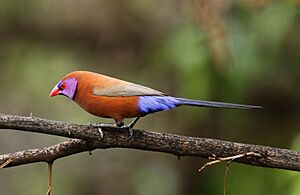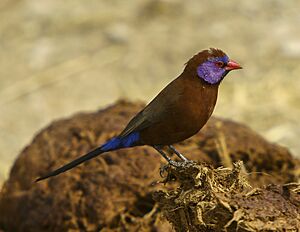Violet-eared waxbill facts for kids
Quick facts for kids Violet-eared waxbill |
|
|---|---|
 |
|
| Conservation status | |
| Scientific classification | |
| Synonyms | |
|
Fringilla granatina Linnaeus, 1766 |
The violet-eared waxbill or common grenadier (Granatina granatina) is a beautiful bird. It is a type of estrildid finch often seen in the dry areas of Southern Africa.
Contents
Discovering the Violet-Eared Waxbill
Who Named This Bird?
The violet-eared waxbill was first officially described in 1766. A famous Swedish scientist named Carl Linnaeus gave it its first scientific name, Fringilla granatina. He wrote about it in his book, Systema Naturae.
What Does Its Name Mean?
The name "granatina" comes from a French zoologist named Mathurin Jacques Brisson. In 1760, he called the bird "Le Grenadin," which means "grenadier" in English. This name likely refers to its bright, jewel-like colors, similar to a grenade fruit.
Where Was It First Found?
Linnaeus first thought this bird came from Brazil. However, this was a mistake! Later, scientists corrected its true home to Angola, specifically the Huíla Province. Today, the violet-eared waxbill is part of the bird group called Granatina and is considered a single species with no different types.
Where Do Violet-Eared Waxbills Live?
These colorful birds live in warm, dry places. You can find them in areas with shrubs and grasslands, also known as savanna habitats. They live in several countries in Southern Africa, including Angola, Botswana, Mozambique, Namibia, South Africa, Zambia, and Zimbabwe. Scientists keep an eye on their numbers. Right now, they are listed as "Least Concern," which means there are still plenty of them in the wild.



